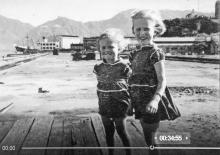At a Council meeting today Franklin Gimson speaks in opposition to a Camp petition calling on the British Government to arrange for repatriation from Hong Kong.
He states that those involved must be prepared to answer a charge of 'disloyalty'. His words cause a sensation in Camp and Gimson is eventually forced to explain himself at length to try to dampen the outrage.
At the same time, a message Gimson's smuggled out of camp on the same subject is being passed on to London by the British Consul in the Carribean colony of St. Vincent - it's got to him via Shanghai. He was worried that if the entire British community was repatriated - as was being rumoured when he got the message out of Stanley - the British claim to sovreignty over Hong Kong would disappear. He therefore urged the Government to leave him behind with a 'nucleus of administration to take control of colony as soon as the Japanese withdraw'.
Whatever people feel about his powers of tact, or about his determination to keep Hong Kong British, no-one can doubt his courage and commitment.
Captain Kyoda makes an unsuccessful attempt to go down with his ship, the Lisbon Maru. At 9 a.m. Lieutenant-Colonel 'Monkey' Stewart of the Middlesex Regiment, convinced the ship is about to go down, gives the order to break out of number 2 hold. A small party succeeds in getting on the deck, and frees some men from the upper section of number 3 hold. But the Japanese have let six 'suicide' guards on board, and they are ordered to begin shooting. Some of the original escapers are allowed to return to their hold without being shot at, but others are continuing to come on deck and the firing continues until the guards are thrown into the sea.
All the holds are open, and anyone who can escapes. After having climbed upto the deck, Captain Cuthbertson of the Royal Scots goes back into the hull of number 2 hold to comfort the sick and dying. He's eventually swept out of the hold by a surge of water as the ship goes under at about 10.30 a.m.
About 1,750 POWs are in the water, some trying to swim to some nearby islands. Four Japanese auxillary transport boats are circling the Lisbon Maru, and as the swimmers approach, some on board shoot at them. For the firts hour or so they fire at anyone coming near and kick back into the water the few who get to the boats.
Tony Banham sums up the situation soon after noon:
At this point, the experiences of those who would survive took three different paths. The stronger swimmers would reach (the) islands under their own power, while those still at sea would either be picked up by Chinese fishermen from the islands, or - possibly because the Japanese now realized there would be survivors - by the Japanese patrol boats.
By sunset today the rescue is largely over - only a handful of men will be recovered from the sea later. About 820 men died during the sinking, others succumbed to conditions in the Japanese work camps where the survivors were sent. 748 men returned home after the war.
Sources:
Gimson in Council: Geoffrey Emerson, Hong Kong Internment, 1973, 67
Smuggled Message: Nicholas Tarling ed., Studying Singapore's Past, 2012, 190, 204.
Lisbon Maru: Tony Banham, The Sinking of the Lisbon Maru, 2010, Kindle Location 1601-1900

